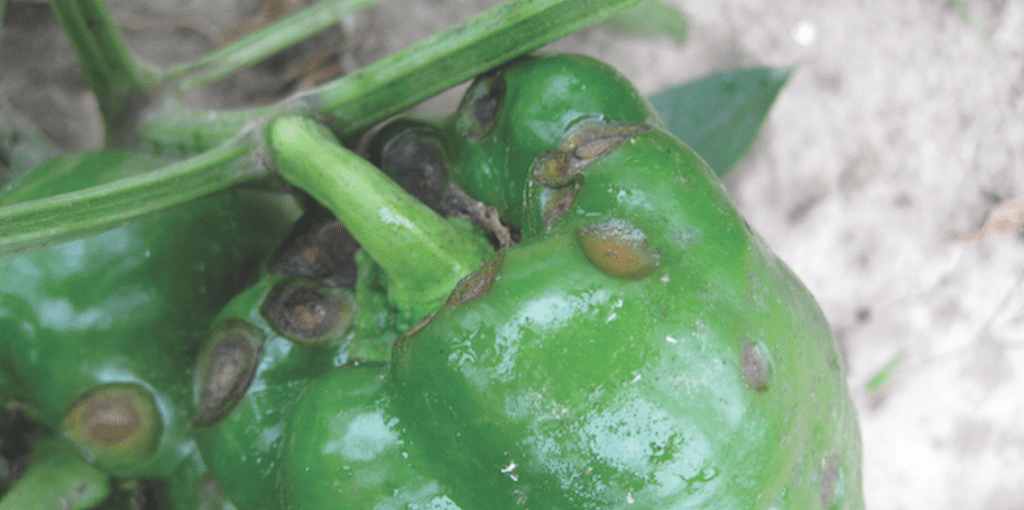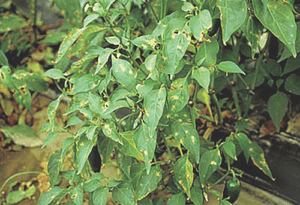

Mar 17, 2020Managing pepper diseases requires layered practices
Peppers face fewer plant pathogens than other crops but diseases are still a big concern.
“Peppers get fewer diseases than tomatoes but in general they get hammered harder,” said Sally Miller, professor in vegetable pathology at Ohio State University and a speaker at the recent Great Lakes Fruit, Vegetable & Farm Market EXPO in Grand Rapids, Michigan.
Anthracnose was a non-issue in peppers a decade ago but has emerged as a major concern. It’s favored by warm, wet weather and the damage mainly appears on the fruit. “It’s extremely aggressive,” Miller said. The anthracnose lesions on the peppers are full of spores that are moved around by rain or irrigation.
White mold is favored by cool, wet, humid conditions and can be more of a problem in hoop houses where there is less air movement and higher humidities.
Grey mold (botrytis) is favored by cool, moist, humid conditions. It has many hosts, produces many spores and is ubiquitous to pepper production.
Pythium root rot is favored by saturated soils, kills the roots and may even spread up into the crown. “I see the most of this when you plant peppers into cool, moist soil and then it gets hot,” Miller said. The result is moisture stress and stunted, unproductive plants.
Phytophthora often starts in low spots or other areas of poor drainage. It’s favored by warm, rainy conditions and can be spread by contaminated surface water. It’s a long-lived pathogen – both in the soil and in water.
Bacterial leaf spot is the most common and most important bacterial disease of peppers. It’s seedborne and can overcome disease resistance. It’s triggered by hot, moist conditions but is short-lived in the soil in cool climates.
“The key through all of this is moisture,” Miller said. “Moisture is the driver for all of the pepper diseases.”
Bacterial canker is a devastating, seedborne disease of tomatoes, but is less common in peppers. It affects peppers but doesn’t kill them and can be mistaken for other diseases. Bacterial canker’s classic symptom on peppers is rough, raised spots on the underside of leaves.
Bacterial soft rot is favored by warm, wet weather. It infects plants through wounds and is associated with insect damage of the fruit.
Syringae leaf spot has emerged as a new, seedborne, bacterial disease. “It looks like bacterial leaf spot,” Miller said, and is often misidentified.
Transmission tendencies
Virus diseases that affect peppers fall into two categories – insect-transmitted and mechanically-transmitted.
Insect-transmitted viruses include the tosporviruses which are most typically transmitted by thrips. These viruses include tomato spotted wilt virus (TSWV) and impatiens necrotic spot virus (INSV). Cucumber mosaic virus (CMV) is another insect-transmitted virus and is spread by aphids.
Mechanically-transmitted viruses include the tobamoviruses which include tobacco mosaic virus (TMV) and tomato mosaic virus (ToMV).
Tomato brown rugose fruit virus (TBRFV) is new and also mechanically-transmitted. “It was only recognized a couple of years ago and has turned the tomato and pepper industries into an uproar,” Miller said. TBRFV is a very serious disease that is not present in the U.S. and has led to numerous USDA import restrictions (see Vegetable Growers News, January 2020 issue, page 18).
Integrated approach required
Managing pepper diseases requires an integrated management program.
Many pepper diseases – especially those caused by bacterials – are seedborne and the message continues to be only use clean seed. “Use certified seed,” Miller said. “But remember, ‘pathogen-tested’ does not guarantee ‘pathogen-free’.”
Treating seeds with hot water or dilute bleach is important and works best with raw seed. “Seed treatment with bleach is quite simple,” Miller said.
The Ohio State University Extension Factsheet Hot Water and Chlorine Treatment of Vegetable Seeds to Eradicate Bacterial Plant Pathogens is an excellent guide on seed treatment and is available at: https://u.osu.edu/vegetablediseasefacts/management/hot-water-seed-treatment/.
“When you decide to treat seed, treat all of the seeds going into a seed lot,” Miller said. Always pre-test seed before treating a large seed lot. Don’t produce transplants from treated and nontreated seeds in the same greenhouse.
Choose resistant varieties but know the issues.


Resistance to phytophthora root rot is only in the root and crown phases. The fruit and foliage remain susceptible.
Bacterial leaf spot resistance is complicated by the pathogen having multiple races. The pathogen may overcome the resistance but so far it isn’t a common problem.
There isn’t any specific resistance to syringae leaf spot but the disease is so weather-dependent that may not be a concern. “This a cool weather disease,” Miller said. It declines rapidly when the weather heats up in mid-summer.
Pepper types vary in their susceptibility to bacterial canker. “All peppers are susceptible but canker is less common on banana and jalapeno peppers,” Miller said.
Resistance to TMV/ToMV is commercially available. “Viruses change rapidly,” Miller said. “You may not want to rely totally on resistance as your control strategy.”
Use pathogen-free transplants and the key is sanitation.
Sanitize equipment and tools regularly, clean and sanitize the greenhouse after each crop, sanitize any surface water you’re using, and only use new or sanitized plug trays. “It’s all about sanitation,” Miller said.
If you’re adding biological products to the soil media for root pathogens, adding a 10% compost or drench mixcan help. “If you have good quality compost, mix that in with your biological products to reduce the root pathogens such as pythium and rhizoctonia,” Miller said.
Install solid flooring in the greenhouse or raise the seedlings off the floor. Ornamentals can have thrips so ornamentals in the same greenhouse as peppers pose a tospovirus risk.
Smokers in the greenhouse are tobamovirus risks. Limit the movement of any contaminant source – workers, tools or equipment – between greenhouses.
Plan to use two to three applications of copper, streptomycin or biologicals for bacterial diseases.
Use water wisely
Water only as much as needed for good seedling growth to reduce the risks of pythium and the bacterial diseases.
“The big thing is water,” Miller said. “We recommend dry growing. Give the plants what they need but don’t overwater.” For field production, chose a well-drained site that’s sunny, has good air movement, and rotate. “Rotation is critical,” Miller said.
Rotation must be out of any crop in the tomato, eggplant or pepper family. For bacterial leaf spot, growing peppers or any other host crop every other year is adequate. For canker and syringae leaf spot, plant peppers or a host crop no fewer than one year in three and for phytophthora or white mold no fewer than one year in four or five. If phytophthora blight is the concern, you must also rotate away from cucurbits or beans.
Use the best cultural practices. Clean and sanitize equipment and sanitize hands, boots and tools between fields. Don’t handle plants when they’re wet and raised beds can help with phytophthora and pythium.
Fungicides are a must. Only use products labeled for the situation, rotate fungicide classes and consider biological/biorational products.
The Midwest Vegetable Production Guide at www.mwvegguide.org is a good source of product registrations for Midwest growers.
— Dean Peterson, VGN correspondent














